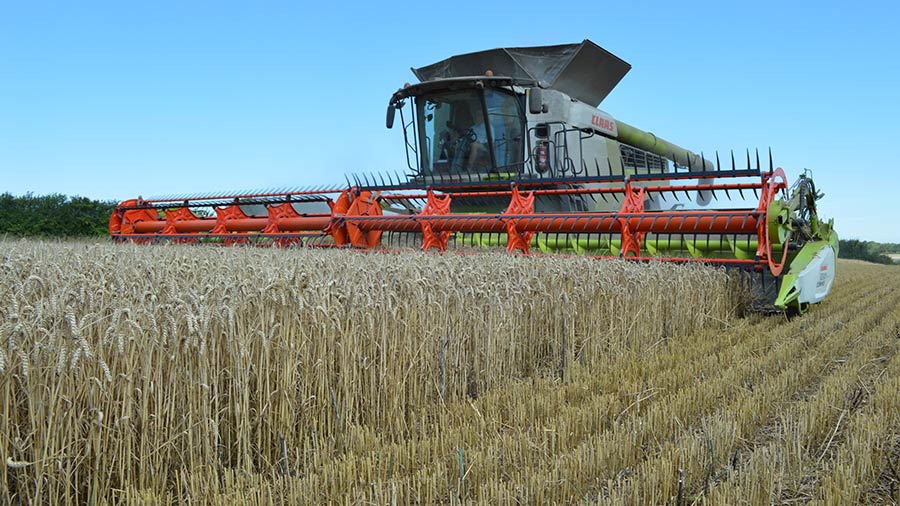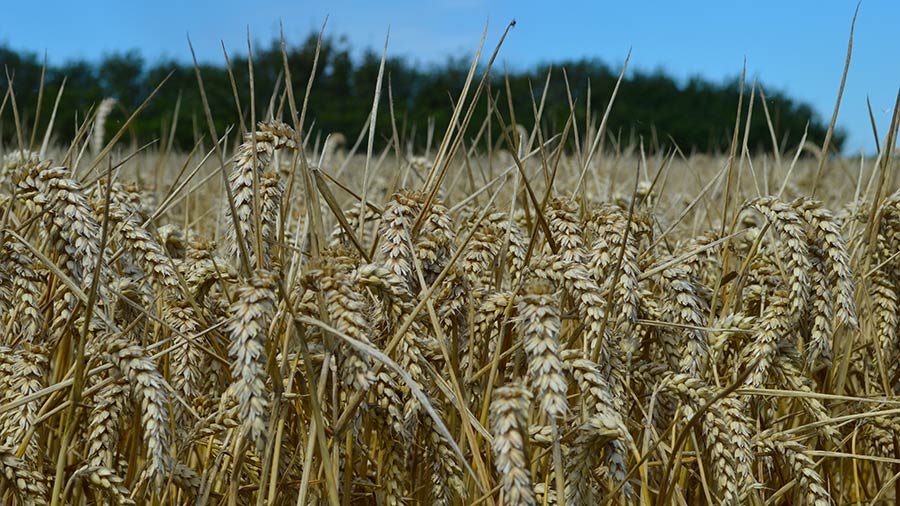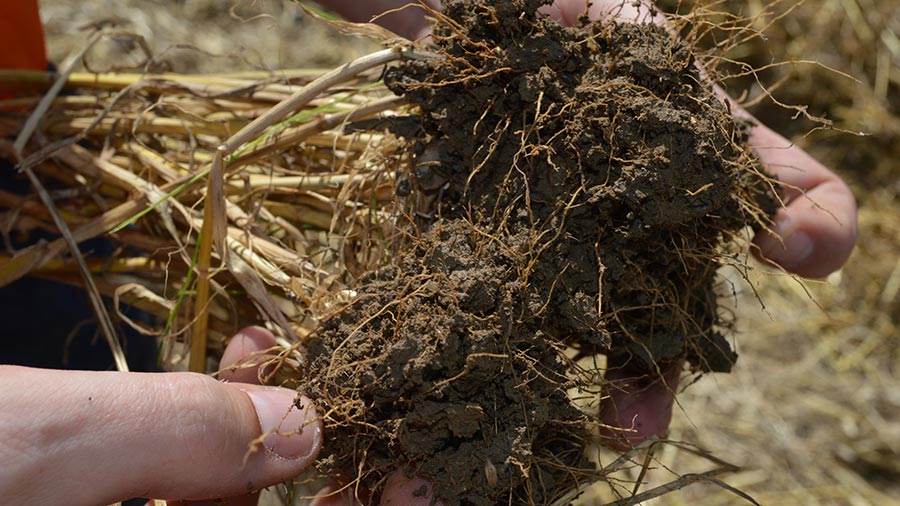Wheat yields good but doubts on quality for 2023 harvest
 Harvesting winter wheat variety Dawsum on Driver Farms © MAG/David Jones
Harvesting winter wheat variety Dawsum on Driver Farms © MAG/David Jones The wheat harvest picked up pace in the recent dry spell, with yields surprisingly good after such a wet and stormy July, although milling quality is a concern with proteins generally low and Hagbergs under pressure.
Suffolk father-and-son growers Carl and Adam Driver have finished 155ha of Extase with a yield of 8.7-9.7t/ha, in line with an expected yield of 9t/ha, for a variety which suits their farm, grown as a direct-drilled second wheat.
Grain protein was low at 10.5% on a farm which often struggles to get high values on its heavy clay land, and produced a high Hagberg at 350-380, showing good gluten quality. Specific weight was right on the breadmaking standard at 76kg/hl.
See also; Harvest 2023: Some good oilseed rape yields but most are down
Possible premium

Dawsum wheat © MAG/David Jones
The Group 2 milling variety was cut in late July at 16-19.5% moisture, and they are hoping for some premium over feed wheat with the grain sent to local co-operative Camgrain.
Carl is currently chairman of the co-operative and Adam a director.
Millers generally look for wheat at 13% protein, 250 Hagberg and 76kg/hl specific weight for breadmaking, and low proteins and sliding Hagbergs could mean milling wheats may be short this season.
The business, Driver Farms, based at Britton’s Farm, Brockley, a few miles south of Bury St Edmunds, also grows the Group 4 hard feed wheats Dawsum and Gleam, and the former is yielding well at 10-12t/ha at a specific weight of 78-79kg/hl with lots of straw.
“It’s been a rainy stop-start harvest, but we have tried to keep cutting as Camgrain can cope with the wetter grain,” says Adam.
“We are very pleased with the Extase and Dawsum,” he adds. With favourable weather, he is looking to finish harvest by the coming weekend.
Extase works well in their system of direct drilling and relatively low inputs of 200kg/ha of nitrogen across all wheats and a fungicide spend of just £70-90/ha. It is drilled late because of its vigorous growth, but harvested early.
The early harvest has allowed the farm to get on with other jobs such as drilling cover crops, cultivations where needed, and 280ha of mole ploughing.

Good soil structure is being seen after 4-5 years of direct drilling in this field © MAG/David Jones
Low proteins
Andrew Blenkiron at Euston Estate, further north on the Suffolk Brecklands, has just completed his 400ha milling wheat harvest with average yields, but low proteins and Hagbergs starting to slide in the last fields to cut.
All the wheat grown is of milling varieties Skyfall and Zyatt, and they yielded 7t/ha, which is in line with expectations on the estate’s light blow-away sand just south of Thetford, and using a relative modest 200kg/ha of nitrogen.
“Yields have been average, but proteins were disappointing at around 12.5% with some below 12% due to the dry weather in June, and it’s been an expensive harvest with added drying costs,” says Andrew, the estate director.
Last week, the estate team were cutting wheat at 20% moisture, which came down to 12.5% in drier spells of weather, while Hagbergs, reflecting the catchy weather, started off at 380 but were sliding towards 265 by the end of the week.
Crusoe impresses
Ed Ford in south Essex is cutting 350ha of Skyfall and Crusoe and is seeing better signs on the protein front, with virtually all his grain over 13% and some Crusoe hitting 14.5%, all grown on heavy clay soils.
The Crusoe is yielding slightly below expectations at 8.5t/ha, while two blocks of Skyfall are better at 9.4t/ha and 10t/ha.
Hagberg levels started off “north of 350”, he says, but are becoming a “concern” in the current showery weather at Childerditch Farms, just south of Brentwood.
The farm does not cut wheat above 18% moisture, but this season’s variability has been tricky, with wheat being cut at 15% one evening and then at 17% the next morning.
“The harvest is frustrating because of the weather, but the results so far are not too bad,” says Ed.
Lower wheat harvest
Grain traders are expecting a slightly lower UK wheat harvest, with variability in protein and a possible slide in Hagberg levels likely to lead to more imports of quality milling wheats.
They are looking for a harvest of 14.6m-15.1m tonnes after 2022’s 15.5m tonnes, but the weather is still unsettled and may reduce yields further.
James Maw, managing director of grain trader Viterra, formerly Glencore, says: “The wheat harvest is challenging from a quality point of view and the very variable results we are seeing so far make it difficult to predict yields at the moment.”
The AHDB has forecast the winter wheat area for this season to be down 3% at 1.746m hectares in its July planting and variety survey, although some traders believe the area may be up slightly due to late drillings using farm-saved seed.
Cold wet spring
Agronomist David Robinson says the low proteins this season are likely to be due to the cold, wet spring through March, April and into May, which set wheat crops’ growth back and reduced their ability to take up nitrogen from the soil.
“Wheat crops went backwards in the spring and there was a knock to root and foliar growth, making them less resilient to cope with the hot weather in June,” says David, who is head of Frontier’s Crop Dynamics, a group of growers who pay for agronomy advice.
On a more positive note, in Suffolk Adam’s other crops have produced good quality, with Electrum winter malting barley yielding 6-7.5t/ha with good low nitrogen of 1.55%, and spring malting variety Laureate yielded 5-7.8t/ha at 1.5% nitrogen.
Spring oats Isabel yielded 5.8-6.8t/ha at an impressively high specific weight of 55-57kg/hl, while winter variety Mascani yielded 6.5t/ha with a specific weight of 51kg/hl.
UK wheat crop – Defra official figures |
||||
| 2019 | 2020 | 2021 | 2022 | |
| Area (m hectares) | 1.816 | 1.387 | 1.790 | 1.809 |
| Yield (t/ha) | 8.9 | 7.0 | 7.8 | 8.6 |
| Production (m tonnes) | 16.225 | 9.658 | 13.988 | 15.540 |
| The UK record wheat crop was in 2008 at 17.227m tonnes | ||||

